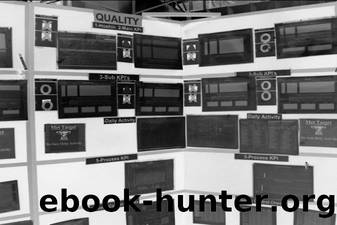Toyota Culture by Jeffrey K. Liker

Author:Jeffrey K. Liker
Language: eng
Format: azw3
Tags: Toyota Culture
Published: 2011-10-04T10:24:24+00:00
Clean and Safe Workplace
285
Ernie and Terri are very encouraged with the progress made over a few years in the safety culture of the plant and are working hard sharing the lessons learned with other Toyota plants.
TEAM MEMBER CARE—PERSONAL HEALTH
AND SAFETY
While the goal is zero injuries, things happen. They happen at work and they happen outside of work. There is still a need to care for team members.
Dealing with Workers on Restrictions
What do you do when a team member does develop some sort of work restriction?
The conventional response is send them home. Ernie Richardson discovered that, in fact, sending them home may not be best for the company or the injured team member:
We made a big improvement in how we treated the team members who did get hurt. We found sending them home was not good for the member or the company. The members were away from their teams and productive work, and many times suffered depression in addition to their physical injury. We also found that it cost about $1.80 an hour more for the company to send someone home rather than remain at work because of insurance costs, and the cost of replacing them with a temporary worker. Our goal became: keeping them working and finding them productive work somewhere in the plant that was acceptable given their injury. This was a mind shift for everyone involved: insurance carriers, group leaders, managers, and the team members.
We work harder on restriction management. We now have computer programs with lists of jobs that people with certain injuries are able to perform.
We punch in the person and their injury and up comes all the jobs in the plant that the person can do.
The first goal is to keep them in their section. So a member in assembly may work most of the day in their team, but be able to work for a two hour rotation in another part of the assembly plant. This is considered a non-rota-tional job and is temporary. The goal is to get them back to a full rotation of jobs in their team. For restrictions that are more serious and where we can’t find a way for them to keep working on the line, we have developed an Extended Job Placement (EJT) program. This program is designed to find the restricted members an off-line, value-added, productive job for the team member to work, and receive a reduced amount of pay while they rehabili-tate their way back to the line. We have 22 team members in the program right now, and have already sent five back to their old normal rotations.
286
Toyota Culture
Medical Clinics on Site
From the beginning, Toyota has always had medical clinics on site at TMMK
that are staffed with contract doctors and nurses to take care of work-related medical care. They have made two big improvements that have allowed expansion of these services. The first is that with all of the safety improvements already described, fewer members require the services of the clinic for work-related issues. The
Download
This site does not store any files on its server. We only index and link to content provided by other sites. Please contact the content providers to delete copyright contents if any and email us, we'll remove relevant links or contents immediately.
| Agile | Lean |
| Quality Control | Six Sigma |
| Total Quality Management |
Hit Refresh by Satya Nadella(8338)
The Compound Effect by Darren Hardy(7559)
Change Your Questions, Change Your Life by Marilee Adams(6641)
Nudge - Improving Decisions about Health, Wealth, and Happiness by Thaler Sunstein(6633)
The Black Swan by Nassim Nicholas Taleb(6191)
Daring Greatly by Brene Brown(5641)
Deep Work by Cal Newport(5464)
Principles: Life and Work by Ray Dalio(5322)
Rich Dad Poor Dad by Robert T. Kiyosaki(5149)
The Myth of the Strong Leader by Archie Brown(4789)
Man-made Catastrophes and Risk Information Concealment by Dmitry Chernov & Didier Sornette(4736)
Big Magic: Creative Living Beyond Fear by Elizabeth Gilbert(4723)
The Slight Edge by Jeff Olson(4722)
Discipline Equals Freedom by Jocko Willink(4635)
Digital Minimalism by Cal Newport;(4542)
The Motivation Myth by Jeff Haden(4526)
Stone's Rules by Roger Stone(4415)
Management Strategies for the Cloud Revolution: How Cloud Computing Is Transforming Business and Why You Can't Afford to Be Left Behind by Charles Babcock(4131)
The Doodle Revolution by Sunni Brown(4043)
